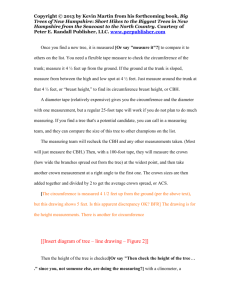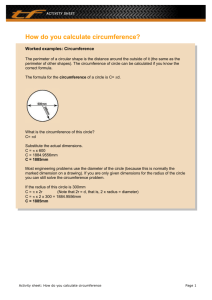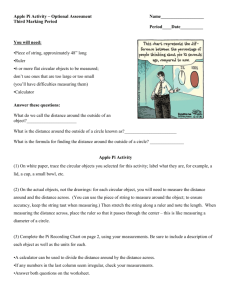ForestEcology Teaching Unit-Boughton 2011
advertisement
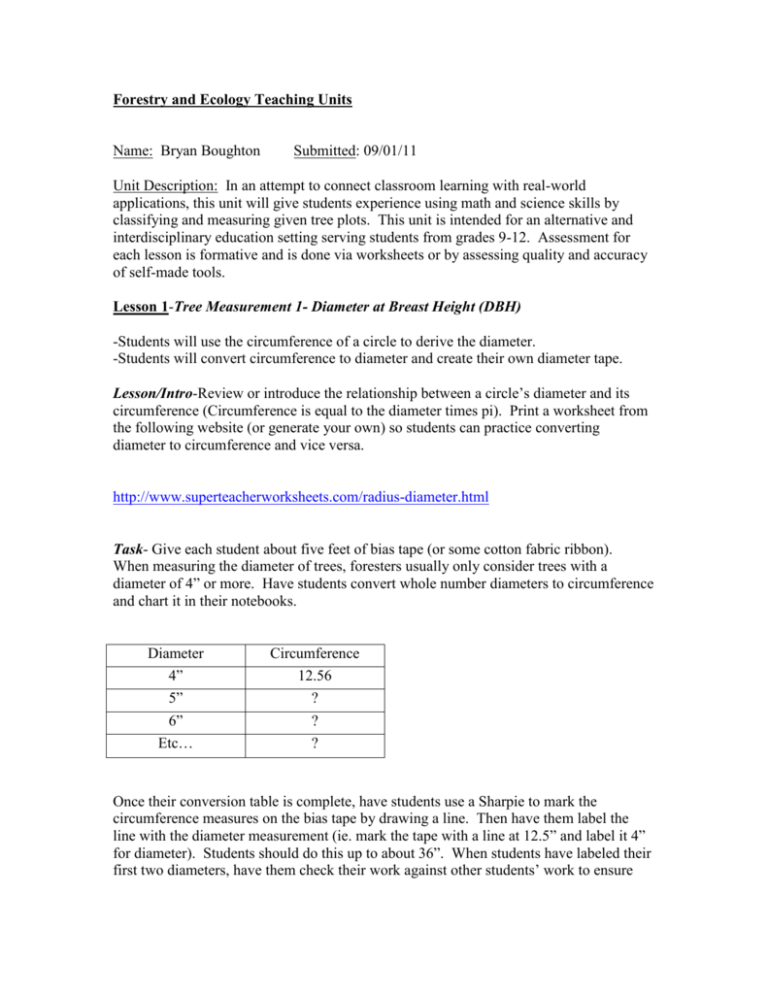
Forestry and Ecology Teaching Units Name: Bryan Boughton Submitted: 09/01/11 Unit Description: In an attempt to connect classroom learning with real-world applications, this unit will give students experience using math and science skills by classifying and measuring given tree plots. This unit is intended for an alternative and interdisciplinary education setting serving students from grades 9-12. Assessment for each lesson is formative and is done via worksheets or by assessing quality and accuracy of self-made tools. Lesson 1-Tree Measurement 1- Diameter at Breast Height (DBH) -Students will use the circumference of a circle to derive the diameter. -Students will convert circumference to diameter and create their own diameter tape. Lesson/Intro-Review or introduce the relationship between a circle’s diameter and its circumference (Circumference is equal to the diameter times pi). Print a worksheet from the following website (or generate your own) so students can practice converting diameter to circumference and vice versa. http://www.superteacherworksheets.com/radius-diameter.html Task- Give each student about five feet of bias tape (or some cotton fabric ribbon). When measuring the diameter of trees, foresters usually only consider trees with a diameter of 4” or more. Have students convert whole number diameters to circumference and chart it in their notebooks. Diameter 4” 5” 6” Etc… Circumference 12.56 ? ? ? Once their conversion table is complete, have students use a Sharpie to mark the circumference measures on the bias tape by drawing a line. Then have them label the line with the diameter measurement (ie. mark the tape with a line at 12.5” and label it 4” for diameter). Students should do this up to about 36”. When students have labeled their first two diameters, have them check their work against other students’ work to ensure that they are doing it correctly. When the tapes are complete, demonstrate how to use the diameter tape to measure cylindrically shaped objects (ie. waste basket, flag pole, etc…). MaterialsBias tape/cotton fabric ribbon (can be found at any craft store or Wal Mart) Fine point permanent marker. Calculator Notebook Circumference/Diameter worksheets Measuring tape (inches) Michigan State StandardsG1.6.1 Solve multistep problems involving circumference and area of circles L2.3.1 Convert units of measurement within and between systems. Lesson 2-Tree Measurement 2- Tree Height. -Students will use trigonometric ratios to determine an unknown height. -Students will construct a clinometer to measure angle of elevation. Lesson/Intro-Review or introduce to students the trigonometric ratios of sine, cosine, and tangent (tangent being most pertinent). Download this activity from the following website or print it from the next three pages of this document. http://faculty.salisbury.edu/~jabergner/prime%20grant/Indirect%20measurement%20with %20a%20clinometer.doc Have students keep their clinometers in a safe place as they will be used toward the end of the unit in lesson 4. MaterialsProtractor 1 heavy piece of paper 12 inch long piece of kite string 1 washer tape drinking straw Calculator with trig functions. Michigan State StandardsG1.3.1 Define the sine, cosine, and tangent of acute angles in a right triangle as ratios of sides. Solve problems about angles, side lengths, or areas using trigonometric ratios in right triangles. Indirect measurement with a clinometer It is not feasible to measure the height of a tall object by running a tape measure along its length and so we must measure it indirectly by measuring other quantities directly and using the proper mathematics to calculate the height. We are going to make a clinometer and use it to measure angles of elevation from our line of sight to the top of a tall object. Suppose we wanted to measure how tall a tree is, consider the following diagram: e Eye level observer ^^^^^^^^^^^^ ^^^^^^^^^^^^^^^^^^^^^^^^^^^^^^^^^^^^^^^^^^^^^^^^^^^^^^^^^^^^^^^^^^^^^ Ground level 1. The angle of elevation, e, is the quantity that we can measure with the clinometer. What other quantities can we measure directly? Label these on the diagram. 2. Using right triangle trigonometry, write down the trig ratio(s) that involve e. 3. Look at your answers to #1 and #2, which trig ratio involving which quantities will allow you to measure the height of the tree? Class discussion Since the angle of elevation plays an important role in your calculations you must measure it carefully. Let’s see what happens if we messed up the angle calculation by 5 or 10 degrees. Activity 2 Now you are ready to find height with your clinometer. Pick out 2 objects from the list below that you wish to measure and go to it! Make sure to record your information carefully and take into account what we discussed about measuring the angle of elevation. Find the height of… (insert appropriate items for your school) Item #1:_________________________________ Measurements:___________________________________________ ___________________________________________ Calculations: Height:________________________________ Item #2:_________________________________ Measurements:___________________________________________ ___________________________________________ Calculations: Height:________________________________ Making a clinometer. By definition, a clinometer is an optical device for measuring elevation angles above horizontal (angles of elevation). A metal tube allows the user to sight the top of an object and a protractor-like device on the side measures out the elevation angle. Before the adoption of more accurate devices, surveyors used clinometers to measure the heights of objects. The Abney level is a clinometer that is still in use today because of its accuracy. We are going to construct a clinometer that has a drinking straw instead of a metal tube and that uses a piece of kite string to sweep out our elevation angle. Materials: Protractor 1 washer 1 heavy piece of paper tape 12 inch long piece of kite string drinking straw Construction: 90 Assembling your clinometer Using your clinometer. Attach the drinking straw to the top straight edge of the compass. Start out by holding the clinometer so that the straw is parallel to the ground. Attach the compass to the heavy sheet of paper or file folder as shown above. Slowly tilt the straw up until you can see the very top of the object through the straw. Attach the washer to the end of the string and attach the string to the 0 marking on the top edge and let it hang at least 2 inches below the edge of the paper- so that it can swing freely. Have your partner record the angle measure that the string passes through. Recall, since you start the string at 90 degrees, you must subtract the recorded angle measure from 90 to get the angle of elevation e. Lesson 3-Using a Dichotomous Key. -Students will use a dichotomous key to classify alien creatures from “Pamishan” -Students will use a dichotomous key to classify tree species via the internet. Lesson/Intro- Introduce the importance of being able to classify or identify an individual species or object from other species or objects. Have students try to identify an individual from class by having them ask questions with one word answers like “Is it a boy or a girl”. Give each student a handout printed from the following website http://www.biologycorner.com/worksheets/pamishan.html Students can work independently or in small groups to classify each of the aliens on the worksheet. Once that is completed, give students access to the internet or project the following web site on an overhead. Scroll down and perform the “I.D. a Tree walk” http://nationalzoo.si.edu/education/conservationcentral/walk/ MaterialsInternet access. Pamisham creature dichotomous key handout. Overhead projector/Data Projector. Michigan State StandardsB1.1C Conduct scientific investigations using appropriate tools and techniques. L3.p1A Provide examples of a population, community, and ecosystem Lesson 4- Tree identification. -Students will determine appropriate sample sizes to identify species of trees within the school tree plot. -Students will identify the species of trees within the given sample plot using a dichotomous key. Lesson/Intro- Ask students how they would determine the average number of pennies, nickels, and dimes in a quart jar full of coins. Some will likely say to separate and count the number of each. Ask them further that if we just wanted a close estimate, if there would be a quicker, more efficient way of doing this. Discuss sampling populations for statistical measurement. Several small samples may be taken to represent the entire population. Pose the problem of trying to identify the number of a given species of tree in a local wood plot (ex. how many red maples per acre). You may show students the scope of what an acre is by marking it in the school parking lot or nearby field. What would be an adequate sample area vs. identifying every tree in the entire wood plot. After discussion, lead the class toward 1/10th of an acre per sample plot. Demonstrate why this is an efficient sample area (39ft radius of a circle). Why would this be more efficient than plotting squares (ie. difficulty of ensuring 90 deg. angles and straight lines). Task- Take students to a nearby woodlot where you have already staked centers for sample plots using wood stakes that are marked in a fashion as to be easily identified. Break students into groups of 3 to 5 students. Ensure each group has a notebook, 39ft chain or rope (or adequate measuring tape), diameter tape, and a dichotomous key for tree identification. Have the groups first mark the circumference of their sample areas with marking tape by centering the chain on the post and marking at intermittent points along the circumference. Once the circumference is marked, have them identify and record each tree along with each tree’s measurements of DBH and height. The students should organize data in a similar fashion to that shown below with one count chart and a chart for each species for DBH and height. Species Species # DBH HT This activity is likely to take more than one day depending on time allotted for class. MaterialsDiameter tape (self-made or purchased from Forestry Suppliers Inc. part #39480 Jim Gem Pocket Diameter tape, 10’/38”) Clinometer (self-made) Dichotomous key- Barnes, Burton Verne., and Warren H. Wagner. Michigan Trees: a Guide to the Trees of the Great Lakes Region. Ann Arbor, MI: University of Michigan, 2004. Print (Or similar reference) Wooden stakes (to mark center of sample plots) Marking tape (or something to mark circumference of sample plot) 39’ Chimney chain (or rope, measuring tape, twine.) Notebook/Logbook (for data entry) Calculator with Trig functions Michigan State StandardsB1.1C Conduct scientific investigations using appropriate tools and techniques. L3.p1A Provide examples of a population, community, and ecosystem S4.1.1 Understand and construct sample spaces in simple situations. S3.1.1 Know the meanings of a sample from a population and a census of a population, and distinguish between sample statistics and population parameters. Lesson 5- Graph group data/class data. Interpret data. -Students will use data from their collected measurements and observations and use graphs to compare and contrast between species of trees. Lesson/Intro- Once students have collected all of their data, have them find the average DBH and height for each species. They should also figure out the relative abundance in percent of each species. Have students go the following website and create separate graphs for DBH and height by species. Have them also create a graph for the relative abundance of species. Have students print each graph that they create. After students enter and graph data of their teams observations, have one computer where each team enters their data so that there is a classroom average as well. Print out each graph for classroom data. http://nces.ed.gov/nceskids/createagraph/default.aspx Students may be confused at first with some of the options. It will be interesting to see which graphs they choose to represent their data. Ideally, a bar graph will be used to display DBH and height where a pie chart might better illustrate relative % of each species. Have students self assess how well their graphs represent their data and how well their data matches up with that of the entire class. Discuss why there may be some major discrepancies between sets of data. MaterialsInternet access. Data collected from field measurements and observations. Michigan State StandardsL1.2.4 Organize and summarize a data set in a table, plot , chart, or spreadsheet; find patterns in a display of data; understand and critique data displays in the media. S3.1.4 Design simple experiments or investigations to collect data to answer questions of interest; interpret and present results. Sources Cited"A Walk in the Forest - National Zoo| FONZ." Welcome to the National Zoo| FONZ Website - National Zoo| FONZ. Web. 28 Aug. 2011. <http://nationalzoo.si.edu/education/conservationcentral/walk/>. Barnes, Burton Verne., and Warren H. Wagner. Michigan Trees: a Guide to the Trees of the Great Lakes Region. Ann Arbor, MI: University of Michigan, 2004. Print. "Pamishan Creatures." The Biology Corner. Web. 28 Aug. 2011. <http://www.biologycorner.com/worksheets/pamishan.html>. "Radius & Diameter Worksheets, Circumference & Area Worksheets." Super Teacher Worksheets Printable Worksheets. Web. 01 Sept. 2011. <http://www.superteacherworksheets.com/radiusdiameter.html>. Web. 01 Sept. 2011. <http://faculty.salisbury.edu/~jabergner/prime%20grant/Indirect%20measurement%20wit h%20a%20clinometer.doc/>. "Create A Graph." National Center for Education Statistics (NCES) Home Page, a Part of the U.S. Department of Education. Web. 01 Sept. 2011. <http://nces.ed.gov/nceskids/createagraph/default.aspx>.
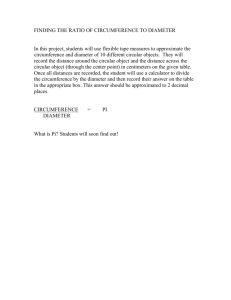
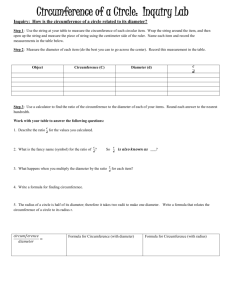
![Chapter 07 5 [MS Word Document, 1.2 MB]](http://s3.studylib.net/store/data/007601121_2-dd2a53bb27839b4742066a393d71d969-300x300.png)

